You’ve heard the saying – if it ain’t broke, don’t fix it? True enough. But there are also things you can’t fix once broken. The car will never be quite right again – and may be a lot wrong.
These Irreparables include:
* Water damage –
This has always been a killer; a water-logged interior almost inevitably means a soon-to-be-moldy interior. Carpet and insulation sops up the water, wicking it up into places that are dark and not well-ventilated. If areas like the interiors of door panels, the underside of the roof, the trunk and so on that aren’t supposed to get wet do get wet, they often rust out quickly, too. And with late-model, computer-controlled cars that have lots of electronics, there is the additional problem of corroded connections and moisture penetration of electrical parts that lead to endless “little problems” that end up becoming big expenses and a constant hassle.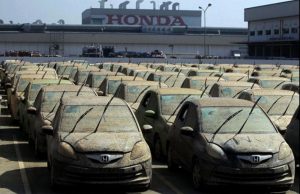
Short of gutting the entire interior – an even bigger expense and hassle – it is almost impossible to truly get back to where you were, before the car went for a swim.
This is why water-damaged cars are often title-washed, then patchouli’d with New Car Smell (to cover up the mold smell) and sent to a different part of the country and sold to unsuspecting suckers.
How to avoid: Running a CarFax or similar title check may uncover evidence of title-washing but it’s not foolproof. Your eyes – and nose – are at least as valuable as far as sussing out a once-wet car.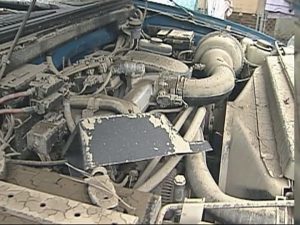
Look for signs of discoloration inside the car, especially door panels, carpets and the headliner. Pop the hood and look a the underside as well as the engine. If you see mud, not splattered but uniform, it is a Bad Sign.
Put your hand under the seat and feel for dampness. If you can, get on your back and – with a flashlight – look up under the dash, from the area near the brake and gas pedals.
If the car was under water, you will see evidence of it here in the form of rust on exposed metal parts and discoloration of insulation. Stick your fingers in the AC and heat vents; if they come out sticky, you may have a problem. Drive the car with the windows up; if the interior glass begins to fog almost immediately, it is indicates a Moisture Problem.
If the car smells musty, it is a Bad Sign. Assume it’s a an ex U-boat and move on to the next candidate.
The mighty German battleship Bismarck was laid low by a lucky (for the Brits) hit to a vulnerable area – her rudders. Though the rest of the ship remained fully operational, her 15 inch guns just as lethal – with her rudder jammed to port, she was a sitting duck for the British fleet because all she could do was steam in circles.
Cars are similarly vulnerable. The parts that are welded together into a single piece – the unibody – are not easy to fix once damaged. Especially modern unibody cars, which are welded together by robots at the factory, to extremely close tolerances. When one gets rear-ended after it leaves the factory, the doors – or the trunk – sometimes never quite close right, even after they’ve been “fixed.”
Sometimes, they leak, too.
The most vulnerable parts are the rear quarter panels (the areas above and behind each rear wheel), the door frames (the doors themselves unbolt easily and can be replaced with new doors, if need be) and the rear end of the car.
A new problem is aluminum unibody vehicles – like the new Ford F-series trucks, for instance. Many other vehicles (e.g., new BMWs, Teslas, Jaguars) make extensive use of aluminum panels, too. Aluminum is light and strong – but it is also more difficult (and so, expensive) to weld back into shape. Once bent, it may not be fixable – or at least, not economically fixable.
You may want to take this into consideration before you buy an aluminum-bodied vehicle.
Once a car has been smoked in, it will always smell like an ashtray – even if immersed in patchouli.
Be especially wary of any used car you’re looking at that does smell as though it has been immersed in patchouli. They do this to mask the underlying cigarette stink but all it does is combine the two stinks into a new, even worse stink. The patchouli stink will eventually dissipate, but the smoke stink won’t – no matter what you do.
This is why smoked-in used cars are always worth about 10-20 percent less at trade-in time than an otherwise identical but never-smoked-in car. If you smoke, you may want to consider that before smoking in your next new car.
This one’s not a functional issue – but like a really bad case of zits, it’s an eyesore. And unlike zits, it’s not easy to fix. Dozens – maybe hundreds – of little divots in the roof and hood are fixable just one way: By replacing the afflicted panels. If it’s just bolt-on panels like the hood, that’s relatively straightforward. But if it’s a welded-together part of the car like the roof – then you’re looking at a lot of work and a lot of bucks and the end result might look okay but might also leak. (See above about unibody panel tolerances and the challenge of getting everything to line up again, exactly right, after a repair.)
The upside, though, is that hail damage is – usually – just a visual thing and doesn’t affect the car’s operation – or longevity. But because it’s an eyesore, you can score a deal. Brand-new or nearly new cars that had the bad luck to be sitting outside on a Texas dealer’s lot when a bad storm rolled through – and got all dimpled up – are sometimes trucked up north and sold at a deep discount.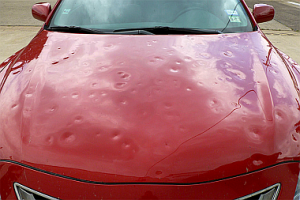
Sometimes, the discount is deep enough to make the car worth fixing. And even if not, there’s nothing really wrong with the car . . . other than it looking less than its best!
If you like what you’ve found here, please consider supporting EPautos.
We depend on you to keep the wheels turning!
Our donate button is here.
If you prefer not to use PayPal, our mailing address is:
EPautos
721 Hummingbird Lane SE
Copper Hill, VA 24079
PS: EPautos stickers are free to those who send in $20 or more to support the site. 


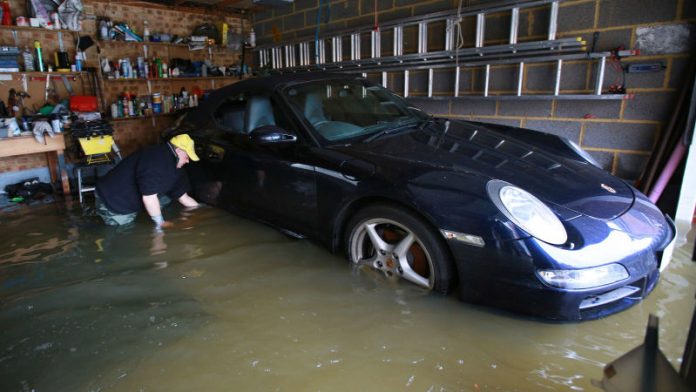

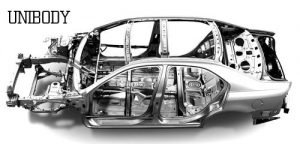
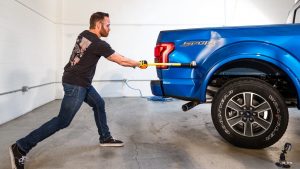

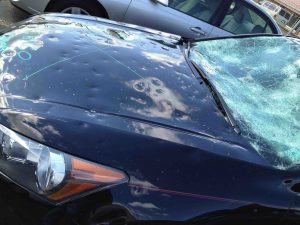







My first restoration project was a ’71 Roadrunner I bought out of a junkyard in the Salinas Valley, CA. Some itinerant farm worker who owned it got drunk with his buddies one night and drove it into a drainage ditch, sinking it up to the dash. I brought it home, stripped it down and did an amateur restoration on it–only problem is I missed getting the mud out of the area in front of the rear wheel wells. A couple years later the tell-tale bubbles appeared in the paint, and I ended up digging a couple pounds of dirt out of each side. A good body man repaired the panels. After I began drag racing it, I started finding fine mud flakes on the floor under the dash after a day at the track. That mud was getting shook loose after a day of 12 sec runs….the only electrical problem I had was corrosion in a connector in the left side door sill—the hot wire connector for the trunk light backed out and shorted out.
I also had a ’74 Mazda RX4 that was smoked in–that took a couple days worth of cleaning to get the ashes out. I thought there was something wrong with the dome light bulb due to it being so dim–turned out to be a coating of brown cig tar on the lens. Got that cleaned and wow it’s white light again!
Now if my gal’s ’05 Lexus LS 430 had been dunked it’d be pretty much destroyed–I’d especially be concerned about all the airbag control modules getting corrosion and going off at random times. That’d get your attention–but in a bad way……
My aunt smoked out her 1974 Chrysler Imperial LeBaron. My dad and I tried cleaning it before she was about to sell it.
There was a brown nicotine residue over the windows that Dad cleaned off using some really nasty-smelling solvent. He used some other solvent to clean the dash. We took out the seats and carpet and saddle soaped the seats and shampooed the carpet. (It took several times to get that residue out!) We took apart the HVAC ducts and washed out what we could.
We completely took apart the trunk and washed it out too.
We used some kind of foam to clean the headliner and door panels.
That took care of most of the smell. We just left the car windows open in the sun and fresh air, and Dad put in these plastic tubs of, I think, activated charcoal to take out the rest.
While it was certainly a significant improvement, if you tried, you could pick up a faint hint of unfiltered Winstons.
Actually I have a Subaru Legacy that was smoked in previously, but over time it has quit stinking. It did stink for a while, but, think about it, the smell is from volatile compounds coming off the interior and into the air in the car. After a couple of years, the volatile compounds deplete (I think this is actually a half-life type situation so technically, yeah, it’s never GONE, but, after about 5 half lives it’s for all practical purposes gone.)
The other issues, yeah, you are right, not practical to “fix”
Mark…I think you just got used to it! 😉
One should be aware that Ozone attacks (breaks) cohesive bonds and oxidizes rubber, especially if it is under stress.
Has any one tried an ozone generating air purifier left in the car for a day or so to destroy mold and tobacco odors?
You missed one: Lightning strike. I know a guy whose care got hit by lightning while driving down the highway at 60 MPH. Fried all the electronics and set the stuff in the trunk on fire (which the fire department then graciously filled with water). The insurance company refused to total it.
A friend has a new 65 Stang and driving along I-20 to work he comes to in the barditch. His car has no glass, everything sorta flattened as he was himself. He cranks it up, turns around and heads back to town where he goes to the hospital(huh? huh? he’s answering to questions). A dry box 18 wheeler hauling fertilizer and dynamite caps had started fire from a flat and cooked off while the driver went for help. Road signs lying flat for miles, signs further away punctured by flak. Back down the way Stuckey’s windowless with their big signs on the ground. A fire dept. arriving on the burning wreck got out just in time to get blown out of their boots. No fire to address when they regained consciousness. The largest part found of the truck was a piece of axle housing. The interstate was closed for a while due to the huge amount of fill that had to be trucked in for the big hole. “They” say there’s a silver lining in even the worst situations. I guess no flat repair needed was the only thing about that one although I think nobody was quite killed, fairly much a miracle in itself. Pieces of truck were found for decades in pastures and fields.
I have to smile reading about smells in a car. I bought a Volare (as close to a classic car as my pathetic budget will ever allow) and it reeked of the previous owner’s cologne. Now, some ten years later, you can still smell just a whiff of that cologne. Must’ve been strong stuff.
Hi Ross,
You have a Volare? I’m jealous!
It’s close to a Cordoba!
Vape smoke will be the next thing to deal with in used cars. My co-worker’s truck smells like a candy shop (but not in a good way) and a sticky film on all the windows. I suppose it’s better than cigarette smoke, but still pretty bad.
in the 80s a friend of mine had has 73 trans Am get flooded to the door handles,
he had it towed to a shop and all the fluids replaced,
he then left it running with the heater on full blast and the windows cracked about an inch, until the entire full tank of gas was used up,
took almost three days.
it dried out nicely, although the electronic stuff got ruined, you know, the Kraco speakes and the Sparkomatic cassete player.
newer cars with a computer to run even the brakes lights, would be of course dead.
I like getting my cars at the auction when the ins companies sell the totalled ones, or at repo auctions.
I beat the wheels off of em for years until they die, then rinse and repeat,
I used to work with a guy who bought $500 cars. If he got 3 months out of one, he considered it a win, versus having a new-car payment. We didn’t bother to ask about all the time he spent in the DMV getting new plates for them all.
Hi Justin,
I’m something of an idiot savant when it comes to second-gen Trans-Ams, having owned a bunch and worked on more and been obsessing about them for decades. Anyhow, your friend’s ’73 probably developed severe rust in the lower rocker panels, quarters, trunk and (of course) rear quarter panels as a result of its swim. Those areas were rust prone to begin with, but if immersed, water would have penetrated into the areas not well protected against corrosion, that trapped water. The only reason my ’76 is still solid is because it hasn’t gotten wet in more than 30 years! 🙂
A place to check for rust that sometimes easier to get to is under the front seats (you don’t have to crane your neck quite as far). A little bit of surface rust is normal (the parts don’t have any coatings on them from the factory), but a lot of rust on them is a serious red flag.
A few hail dents can be fixed using a good paintless dent repair guy. Some of them live in RVs and will chase storms across Texas and Oklahoma – good money to be made doing that. They aren’t like the sketchy “driveway coating” people that rip you off – but you should ask to see reference photos that show them standing next to the before/after repair car to ensure they have good skills.
When I bought the Z 71 it was cigarred up. I tried Febreze on the fabric but no luck. I mixed up some Simple green one day and went over everything on the inside that wasn’t cloth from the b pillar forward. Next day it has almost no odor so I finished the hard parts of the interior and Febrezed the rest of it and the smell was gone, not just nearly but all of it. I was amazed. Simple Green, don’t leave home without it.
I never liked carpet, often removing it from the beaters I drive. I wonder if an immersion in distilled water to get the salt out, followed by a baking could save or at least preserve something like the valuable Porsche pictured? Probably a lot of disassembly of interior, electronics and the fuel systems, with hit or miss results of course. I’ve washed the keyboard I’m typing this on three times in a sink, even heard of people running them through a dish washer(no heat dry, give it a day or two). We don’t get the Midwest hail so much as bumper crops of acorns raining down in New England, with similar results. Everyone cringes a bit and looks to the person who just purchased a new car.
Hi Max,
Remember this?
https://www.youtube.com/watch?v=bodVVtqmbZE
Max, I’ve removed the carpet on lots of cars, scrubbed it clean and rinsed it good letting it dry on the line. Sometimes carpet looks like new after that. That Z 71 had so much limestone dust on it you could barely tell it had carpet on one side. With what I deemed little to lose, I just opened the doors and high-pressure washed it and washed it and washed it till nothing ran out but water. I was being lazy but since we were having hot and dry weather(almost always)I left the windows down about an inch and left it parked in the sun. A couple days later it was completely dry and the carpet had almost no wear on it(whoda thunk it?). That took a lot of smell with it before I did the Simple Green and Febreze thing. You can open the door and smell nothing now. I also changed the dual ventilation filters, a huge plus for any vehicle, esp. ones exposed to dust day in and out.
Instead of using mats with all that area to hold liquid and dirt, I custom cut a big rig mudflap and lay it upside down on the carpet with the slick side up. Last week I was rolling down the road with an open bottle of beer in a slick, aluminum coozy. I hadn’t even taken a drink when I was forced to hit the brakes and tensed my legs at the same time. That flipped the beer over and most poured out into the floor. When I got home the beer had run to the door and drained out just like I intended. The mudflap thing is mainly only good for pickups and full-size SUV’s where the lowest part of the floorpan is next to the door. A quick wipe with a wet rag cured the inside and then the outside. A long mud flap is often large enough to do both front sides($40) and will NEVER wear out if you get a good, heavy-duty flap.
Did the mudflap floors my self, notched the corners so they would lay nicely. Cheap too, $10-15 a piece at napa years ago.
Eric,
That should read “Although I have not used it in an automobile …”
Eric,
Good write up. Regarding smoke smell (or other smells) an Ozone producer may be able to significantly reduce if not remove the aroma. It may require several shock treatments for extended time intervals.
Although I have used it in an automobile, I have had some success using the ozone producer in a basement where smoking happens. Although not inexpensive, it is worth (to me) removing unwanted aromas.
Here is the company I used (https://www.jenesco.com/about_us.htm)
Jenesco Inc.
31 Old Nashua Road
Building 12
Amherst NH 03031
Phone: 603-673-4830